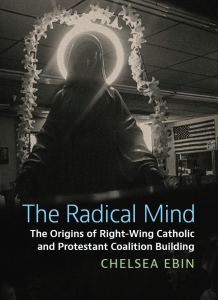While the writing was already on the wall, the results from the Iowa Republican caucus and New Hampshire primary confirmed that Republican voters are willing to look past Donald Trump’s attempt at insurrection and numerous legal battles. As perplexing as it may be for liberals and Democrats, the GOP is all-in for Donald Trump. It seems that it is not only Trump’s message of White Christian nationalism that resonates with conservatives, although that is certainly part of his appeal. His election denialism has also struck a chord. Entrance polling ahead of the Iowa caucus found that a staggering 69% of caucus participants do not believe Biden won the election legitimately. But “Stop the Steal” applies to more than just the 2020 election. It functions as a kind of mantra for many people who feel they are being robbed of the future they were promised by the past.
Trump has always sold his base a reactionary politics of grievance, promising to make America great again by returning the nation to some hazily-defined past era of white majoritarian rule and capitalist triumph. The need for a national regeneration necessarily suggests the presence of decay or rot, which, in turn, opens the door for the right to blame America’s ills on Critical Race Theory, immigrants, queer and trans people, and abortion. Of course, there is nothing new about the right framing its activism as a response to the degeneration caused by the left. Half a century ago, the same discourse played out with only slightly different culprits. In the 1970s, the degenerative threat came from secular humanism and rights-based movements advocating racial, sexual, and gender-based equality. In short, it seems that American conservatives are now–and always have been–fuelled by backlash.
But while many scholars treat the right as reactionary, I believe we should view both the New Right of the 1970s and the modern American right as fundamentally forward-looking and future-oriented. In The Radical Mind: The Origins of Right-Wing Catholic and Protestant Coalition Building (forthcoming from the University Press of Kansas), I argue that we should understand the Christian Right as a movement that was driven less by reactionarism than by a desire to radically remake US politics.
The Radical Mind revisits the origins of the Christian Right in the US, drawing on archival material to re-examine how the conservative Christian political coalition was built and mobilised over a two-decade period stretching from the mid-1960s to the early 1980s. While traditional accounts of the Christian Right tend to emphasise the movement’s evangelical and fundamentalist Protestant roots and its Protestant grassroots base, I focus instead on the importance of Catholic activists and traditionalist Catholicism in shaping the movement. Struck by the seeming convergence of conservative Catholics and Protestants on the right in the 2000s, I set out to examine the origins of their political union, working my way back through the decades. This eventually led me to revisit the well-trod beginnings of the modern Christian Right movement.
Early archival research in the recently processed Paul M. Weyrich Scrapbooks collection at the Library of Congress shed new light on Weyrich’s religiosity, revealing him to be a devout and committed Catholic traditionalist. Based on extensive archival research, my book portrays the movement’s key architects–most notably Paul Weyrich and Connaught Marshner–as traditionalist Catholics whose right-wing activism was informed by their religious beliefs, and who, in turn, helped broker an enduring coalition between conservative Catholics and Protestants, which I term the New Christian Right.
Scholars have long credited the New Right, an insurgent, self-proclaimed “radical” conservative movement with helping to create the Christian Right. In particular, the New Right activist Paul Weyrich is widely recognised as having encouraged the Reverend Jerry Falwell to launch the Moral Majority, a political organisation that promoted conservative social values in American politics. However, the New Right is often portrayed as having been a secular right-wing movement, less concerned with promoting religious values than with the nuts and bolts of US electoral politics. The New Right’s more secular image was, in part, a result of the movement’s unique coalition-building strategy, which enabled it to cultivate distance from its explicitly religious coalition partners even as they worked together. This allowed the New Right to continue to brand itself as “radical” and operate as an insurgent outside movement, even as its core aims were integrated into the mainstream of the Republican Party through the incorporation of the Christian Right into the party.
But how was this coalition of conservative Catholics and Protestants forged? Long accustomed to viewing each other with suspicion, at best, and outright hostility and violence, at worst, Catholics and Protestants were not intuitive bedfellows. Further complicating matters, fundamentalist Protestants tended to adopt an isolationist stance that discouraged forging alliances even with their conservative evangelical brethren and encouraged a retreat from engagement with secular politics. In the post-World War II period, the Cold War went some way to overcome these divisions, as evangelicals, fundamentalists, and Catholics found themselves united in their opposition to godless communism. But conservative Christians were far from united as the 1960s dawned.
On the one hand, internal denominational rifts kept evangelicals and fundamentalists from working too closely together, while anti-Catholic sentiment encouraged Protestants to distance themselves from issues, such as abortion, that were too closely associated with the Catholic Church. On the other hand, White Christians were not mobilised as a political bloc that could be relied upon to vote consistently for conservative candidates. Thus, in order to form a successful Protestant-Catholic coalition, religious political actors had to both overcome the centuries-old antipathy of White American Protestants toward Catholics and align White Christians with the Republican Party.
This was done, I argue, in part, by constructing a shared identity of victimhood among the White Christian grassroots base. But it is no small task to discursively transform a dominant and oppressive majority into a victimised group. Thus, we might ask: how did White American Christians go from viewing themselves as being at the top of a racial-religious hierarchy to perceiving themselves as oppressed?
Conventional wisdom holds that first the New Right, and then the Christian Right, emerged in response to the social, legal, and political transformations initiated by the civil rights and women’s rights movements. This, in a nutshell, is the backlash thesis. Left-wing action provoked a right-wing reaction; the “Rights Revolution” brought about the right-wing revolution.
In The Radical Mind, I do not dispute that Christian conservatives were motivated by historical events and changes during this period. They certainly were. My interest, however, is in examining how right-wing activists constructed backlash “scripts” or “discourses.” I find that the very idea of backlash–i.e., the idea that the right is motivated only in response to the left–is central to the production of a shared identity of victimhood among conservative Catholics and Protestants. Backlash discourses centred on school prayer, desegregation, and abortion all enabled conservative Christians to see themselves as an aggrieved and victimised majority, and to justify their political mobilisation in terms of defending the “traditional.”
But the vision of the past conjured up by right-wing calls for a return to the “traditional” was an imagined one. In the hands of New Christian Right political activists, backlash discourses served to construct false narratives about the past, which in turn were used to justify the creation of new policies.
Under the umbrella of “pro-family” politics, the social policies of the Christian New Right sought to create new forms of embodied social relations and to radically remake the American political system. I call this process “prefigurative traditionalism” and argue that it was key to the development of the New Christian Right’s forward-looking agenda. Prefiguration is a strategy most closely associated with leftist movements, such as worker councils and Students for a Democratic Society, that seek to bring into being a future political world through the lived embodiment of new forms of social relations and political conditions. I contend that the New Christian Right sought to use the coercive capacity of the state to prefigure a new “traditional.” By framing its actions as defensive and reactionary and its proposed goals as a “return” to the “traditional,” the New Christian Right successfully obscured the movement’s fundamentally anti-democratic and illiberal aims.
If all of this sounds vaguely familiar, it is because we are watching a similar process unfold on the American right today. Just as the New Christian Right cast the White Christian majority as victims of a secular humanist agenda, hell-bent on destroying “traditional” gender roles and Christianity, the Trumpist right has cast conservatives as victims of critical race theory, the so-called “trans agenda,” and democracy itself. The language of “making America great again” and “stopping the steal,” is designed to simultaneously conjure an imagined past and cultivate an identity of victimhood.
But that is not all.
The policies that are proposed by the Trumpist right are not intended to return the country to a mythical past. Rather, the vision laid out in Project 2025 is intended to create a radically new America, freed from its liberal and democratic traditions. This is not a reactionary right that aims to hold the line against progressive change. It is a right that seeks not only to deconstruct the state, but to build it anew.
The plan has never been to go back in time. The plan has always been to use the past to create a radically new future. Revisiting the origins of the New Christian Right coalition helps us to better identify the threats posed by the contemporary Trumpist right and to recognise it not as a reactionary movement but as a proactive one.
Note: This article reflects the views of the author and not the position of the DPIR or the University of Oxford.

Cover image of Dr. Chelsea Ebin’s forthcoming book (Summer/Fall 2024 from the University Press of Kansas) The Radical Mind: The Origins of Right-Wing Catholic and Protestant Coalition-Building






